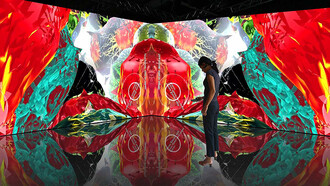Steve Nobel, abstract painter and colorist based in Bozeman, Montana, is a graduate of The School of the Museum of Fine Arts in Boston, Massachusetts. Nobel balances exuberant colors with earth tones in precise and crisp shapes, to freeform shapes and mark making. One can see the influences of Rothko and Klee in his work. Nobel started his academic career at West Point in the Hudson Valley, New York, during a time of political upheaval and social unrest of the late ’60s and early ’70s, notably dwindling support for the Vietnam War. For Nobel, it meant changing his academic and prospective career trajectory. Art became Nobel’s path.
After graduation, he landed in Tribeca, New York, in the mid-70s, where he lived amongst artists in the same building - John Chamberlain, Robert Wilson, and Marisol. Practicality led Nobel to pursue a career in the furniture industry, providing him with a creative outlet with financial stability. A plum job as managing director took him to London with Baker Furniture, and a decade later, he became the president and owner of John Widdicomb Furniture in his home state of Michigan. Fast-forward to New York in 1990, Noble created NOBLELINKS, where he worked with global brands such as Knoll and Kravet on marketing and strategy.
Throughout his career, he kept on painting, and in 2015, he was ready to dedicate himself to it. While looking for studio space, Nobel’s son urged him to consider Montana. Initially, he was dismissive of the idea, and yet, the lure of the big sky and the mountains of Montana brought him in. It was an opportunity for a fresh start out West with a new studio and environment, and one centered on the great outdoors. Nobel has focused his life on family, art, and mentoring others. He is the grandfather of four grandchildren and relishes his time with them.
When he is not at his studio or picking up the children after school, he is mentoring others. He serves on the board of the Danforth Museum of Art. Nobel’s current exhibit, Western Iconography, is on view at the Holter Museum of Art in Helena, Montana, through the end of the year.
Nobel’s passion for art and love of Montana are apparent, and perhaps it will spark some creativity in you.
What is your objective: do you have a specific goal in mind, or are you simply interested in the process and experience of making art?
I read somewhere that for the artist, “Art is a conversation with yourself.” In my view, art-making is less about the end-product. It is a process - an active way of being and knowing. For me, it is always there - in the recesses of my mind - sorting colors and imagining brush strokes and canvas sizes.
Did your work experience in the business end of design inform the way you see and make art?
I want to use the principle of Duality to address this question. Initially, I have to say that I have strength in my left brain (logical, analytical) and right brain (creative, intuitive). As I understand the formal explanation, “duality is a reflection of the complexities of human nature.” I compare this concept to the dichotomy of a professional leader and artistic entrepreneur. That’s me. I draw on my professional leadership skills when serving on the board of the Danforth Museum of Art.
How does art shape us?
From the book Your Brain on Art, I am going to quote some examples: “Art invites us to see the world in new ways.” Written by neuroscientists, it cites their studies of how “art changes our biology, psychology and behavior.” And from Vonnegut, “Creating something is at the core of learning, finding out what’s inside you, to make your souls grow.”
What should everyone know about color?
Color evokes all the senses: sound, sight, and even touch. It is recognizable to the human brain without translation. In my paintings, the nearly sonic vibrations between adjacent colors might be heard by those who are open to them. I am committed to putting color on canvas in whatever manner it takes. My renewed western sensibility and awareness of its atmospherics inspire new art with quiet tension embedded in those colorful adjacencies. This place is a determinative element in my work.
How do you manage your time? How much time do you spend in the studio?
My precious time is dedicated to my family, my community work, and my art. I learn from and am strengthened by all. Making art gives real meaning to ‘lifelong learning.’ An artist learns every day in the studio, so I go every other day, or so. My artistic journey has evolved over decades. It is why I go to the studio: to find out what’s next. Sure, there are disappointments and external speed bumps, but one learns from them, or else repeats them grudgingly. Mine is an internal conflict: to be authentic, not imitative. The imperative is to avoid striving for ‘success.’ What’s more important is to overcome fear of failure or self-doubt, especially when facing big change - like living in Montana, far away from the oases of art in urban areas.
Who are your favorite artists?
DeKooning, Olitski, Donald Judd, Phillip Glass. There’s that duality, again. Each created a lifestyle that embraced their abstract art-making. One summer, I went to the east end of Long Island to peer over the hedges to see DeKooning’s custom studio and home, surrounded by the space and light that apparently reminded him of his native Netherlands and reminded me of western Michigan.
What are some of your favorite museums?
Whitney, MOMA, Berlinische Galerie, Berlin.
What do you do for fun?
Party with friends and family. My duality embraces solitude and social intimacy.














